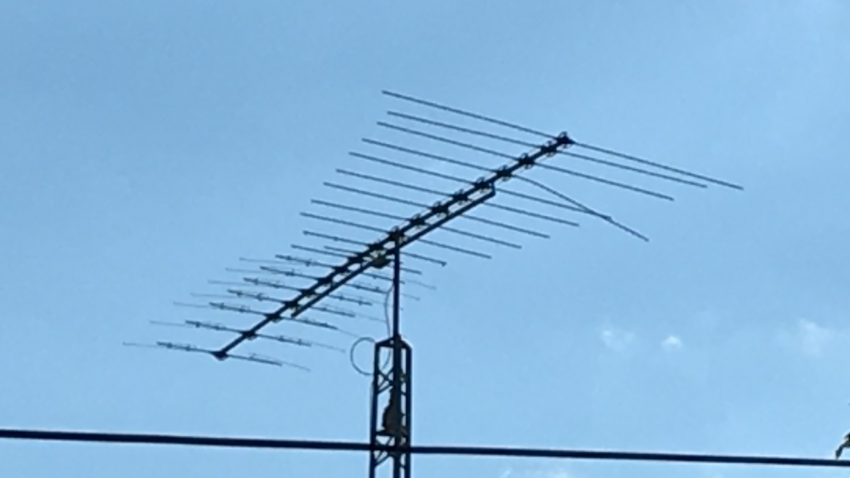When you look at channel numbers for TV stations in adjacent cities, you can see the pattern fits together like a puzzle, or maybe a game of Sudoku:
Some regions have stations on channels 2, 4, 5, 7, 9, 11, and 13. Others have channels 3, 6, 8, 10, and 12.
In analog TV, it was necessary to space VHF stations in the same city at least two channels apart to avoid interference. (There’s a small frequency gap between channels 4 and 5, and a much larger gap between channels 6 and 7.)
Even though digital TV stations can now transmit on adjacent channels, and most stations no longer transmit on the channel they appear as on TV, stations using virtual channel numbers 2 through 13 are drawing on the heritage of the original 1940s and 50s VHF allotments. The FCC still regulates virtual channel assignments because it doesn’t want people between two cities receiving different stations using the same virtual channel.
Back when they were handing out the original allotments, the big cities got the set of channels starting with channel 2. Let’s call this Set A. Then it went in circles, with the smaller cities surrounding the big cities getting the channel set starting with 3. Let’s call that Set B.
Of course, this system is imperfect. Only a few big cities like Los Angeles and New York got the full set of channels allotted to their market. In most other places, the channel sets were spread across a region. Some cities had channels drawn from two different sets.
Here’s a map of how things looked circa 1954 in the Upper Midwest, according to the 1954-1955 Telecasting Yearbook, available at the World Radio History website. “Set A” is in blue and “Set B” is in red:
Here’s a look at the 1954 VHF allotment sets, with a notes on those that changed:
Set A: Twin Cities
2, 5: St. Paul
4, 9, 11: Minneapolis
7: St. Cloud (later moved to Alexandria)
13: Eau Claire, WI
Set B: Northern Minnesota
3, 8: Duluth
6: Superior, WI
10: Hibbing (later moved to Duluth)
12: Brainerd (later moved to Walker)
Set B: Southern Minnesota/Northern Iowa/Western Wisconsin
3: Mason City
6: Austin
8: La Crosse
10: Rochester
12: Notably, this channel is not listed as being allotted to Mankato as of 1954.
Set B: Southern Wisconsin
3: Madison
6, 10, 12: Milwaukee (6 was in the process of being moved from Whitefish Bay)
8: La Crosse (and Grand Rapids, MI)
Set: A: Chicago/Milwaukee/Rockford
2, 5, 7, 9, 11: Chicago
4: Milwaukee
13: Rockford (and Grand Rapids, MI)
Set A: Northern Wisconsin
2, 5: Green Bay
4: Later allotted to Crandon
7: Wausau
9: Iron Mountain, MI (later moved to Wausau)
11: Marinette, WI (later moved to Green Bay)
13: Eau Claire/Calumet, MI (Calumet allotment later moved to Marquette)
Set B: Michigan’s Upper Peninsula
3: Escanaba
6: Marquette
8: later allotted to Iron Mountain
10: Hancock (later moved to Ishpeming)
12: Ironwood (later moved to Rhinelander, WI)
Set A: Far northern Minnesota/Ontario
2, 4: Thunder Bay
5: Fort Frances
9: Later added at Bemidji
11: International Falls (later moved to Chisholm)
13: Bemidji (later moved to Hibbing)
Set B: Red River Valley
3, 6: Winnipeg
6: Fargo
8: Devils Lake
10: Grand Forks (later moved to Thief River Falls)
12: later added at Pembina
Set A: Red River Valley
2: Grand Forks
4: Valley City
7, 9: Winnipeg
11: Fargo
Set B: Eastern South Dakota/Minnesota
3: Watertown (station actually licensed to Garden City and then Florence)
10: later added at Appleton
12: Huron
Set A: Siouxland
2: Vermillion
4, 9: Sioux City
5: Mitchell
7: Omaha (later also became a digital allotment in Sioux Falls)
11, 13: Sioux Falls
Set B: Eastern/Central Iowa
2, 9: Cedar Rapids
4: Rock Island, IL
5: Ames
7: Waterloo/Hannibal, MO
11, 13: Des Moines
Set A: Southeastern/Central Iowa
3: Kirksville, MO
6: Davenport
8: Peoria, IL (later moved to Moline)/Des Moines
10: Quincy, IL
12: Iowa City
Set B: Midlands
3, 6: Omaha
8: later added at Albion, then moved to Lincoln
10, 12: Lincoln
Set A: Central Nebraska
2, 4: North Platte (4 later moved to Hay Springs and Superior)
5: Hastings
7: Later added at Bassett
9: Later added at North Platte
11: Grand Island
13: Kearney (station was originally licensed to Holdrege but was listed as a Kearney allotment)
Set A: Western/Central South Dakota
4: later added at Pierre
5: Lead
7: Rapid City
9: Later added at Rapid City
11: Later added at Lead
13: Later added at Eagle Butte
Set B: Western/Central South Dakota
3: Rapid City
6: Pierre (later moved to Reliance)
8: Later added at Martin
10: Pierre
12: Sheridan, WY
Set A: Western North Dakota
2, 4: Dickinson (4 later moved to Williston)
7, 9: Later added at Dickinson
5: Bismarck
11: Williston
13: Minot
Set B: Western North Dakota
3, 12: Bismarck
6, 10: Minot
8: Williston

